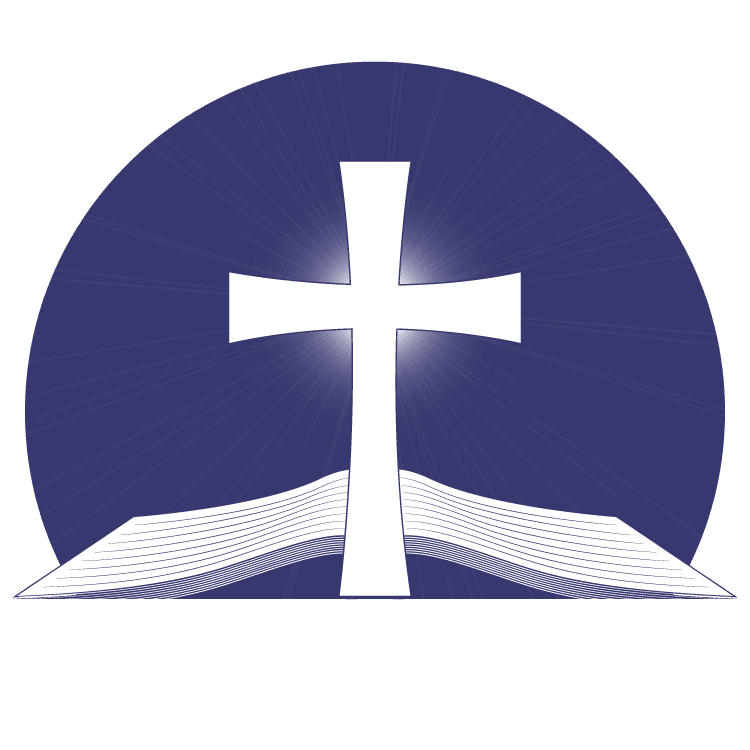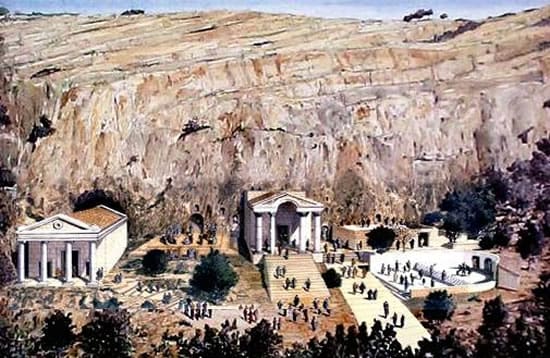Old Testament Reading – Isaiah 53:1-12
New Testament Reading – 1 Corinthians 15:1-8
Jesus’ Journey to Jerusalem
“From Caesarea Philippi to Jerusalem”
Matthew 16:13 – Matthew 26:13
Wayne J. Edwards, Pastor
In A.D. 29, after John the Baptist was beheaded, Jesus moved His ministry from Capernaum to northern areas of Israel around Caesarea Philippi.
- Caesarea Philippi was named in honor of Caesar Augustus, who, in turn, gave it to his son, Philip, who turned it into a place where the elite could go for a time of hedonistic pleasure.
- Beneath this massive rock mountain were pagan statues and 14 temples where the early Canaanites worshiped their false gods, even sacrificing their firstborn children.
- Mount Hermon was where the events described in Genesis 6 occurred. The Nephilim took for themselves daughters of humans and had children by them.
- Caesarea Philippi was also where King Jeroboam built one of his two adulterous centers for worship, complete with golden calves.
- In Jesus’ day, the most important god in Caesarea Philippi was Pan, the Greek god whose lower body was like a goat, with the neck and head of a man. The Greeks believed Pan, who was the god of fertility, was born in a cave near that mountain, and each spring, the people would come there to participate in decadent and debased sexual activity as their worship of the false god of Pan.
Against that backdrop of wickedness, the worship of false gods, and the false worship of the one true God, Jesus said He would build His Church and that even the gates of hell would not stand up against it.
1. Peter’s Confession of Faith – Matthew 16:13-16 – “When Jesus came into the region of Caesarea Philippi, He asked His disciples, saying, who do men say that I, the Son of Man, am? So, they said, some say John the Baptist, some Elijah, and others Jeremiah or one of the prophets. He said to them, but who do you say that I am? Simon Peter answered and said, you are the Christ, the Son of the living God.”
- This was the first public confession of faith recorded in the Bible.
- By declaring Jesus as the Christ, Peter recognized Jesus as the Messiah; the Savior sent from God.
- By proclaiming Jesus as the Son of God, Peter recognized Jesus’ deity – His equality with God.
- A confession of faith in Jesus as the Messiah recognizes Jesus as:
- The Prophet who was sent to reveal to us God’s will.
- The Priest who would sacrifice Himself for our sins.
- The King who is Lord over all creation.
- Therefore, a genuine confession of faith is our agreement with God:
- That we are sinners in need of a Savior.
- That no one can come to the Father but through Jesus.
- Jesus is the Savior we must have.
- Contrary to the false teachers today, a sinner cannot be saved apart from their full confession of faith in Jesus Christ as Savior and Lord.
- Jesus blessed Peter for his boldness, but then He humbled Peter, by reminding him that such knowledge had been given to him by God.
- “Everyone who believes that Jesus is the Christ has been born of God.” (1 John 1:51)
2. Jesus Declaration to Build His Church – Matthew 16:18 – “And I tell you that you are Peter, and on this rock, I will build My church, and the gates of Hades will not prevail against it.”
- While God used the Apostle Peter to birth the Church on the Day of Pentecost, the foundation of the Church is built upon Jesus Christ alone.
- In the Greek language:
- Peter is “petros,” which means a small stone or a pebble.
- Rock is “petra,” which means a boulder or a foundation stone.
- Jesus pointed to that rock mountain where Satan ruled, where ungodly people worshipped false gods and participated in ungodly behavior.
- Jesus pointed to Peter and said, “Upon this rock,” – upon the personal confessions of faith of those who will believe in Him, as Peter had.
- Jesus referred to Himself as the Rock of Ages, the foundation stone of the Church, and to Peter, who was the first “living stone” to be laid upon that foundation.
- In 1 Peter 2:5, the Apostle said those who confess their faith in Jesus Christ as their Savior and Lord are “Living stones, which are being built up as a spiritual house, a holy priesthood.”
In Matthew 16:21, “From that time Jesus began to show to His disciples that He must go to Jerusalem, and suffer many things from the elders and chief priests and scribes, and be killed, and be raised the third day.”
- Peter rebuked Jesus for saying He would be killed, for like all Jews, Peter wanted the Messiah to overthrow the Roman Government and restore Israel’s independence.
- Jesus rebuked Peter; even calling him the “mouthpiece of Satan,” for God had sent Him into the world to give His life as a ransom for sin.
- In Matthew 16:24, Jesus reminded Peter, “If anyone desires to come after Me, let him deny himself, and take up his cross, and follow Me. For whoever desires to save his life will lose it, but whoever loses his life for My sake will find it.”
3. Jesus’ Transfiguration Before Peter, James, and John – Matthew 17:1-3 “Now after six days Jesus took Peter, James, and John his brother, led them up on a high mountain by themselves; and He was transfigured before them. His face shone like the sun, and His clothes became as white as the light. And behold, Moses and Elijah appeared to them, talking with Him.”
- Even though Jesus ministered to the people and performed many miracles, His main priority was to prepare His disciples for His death, burial, resurrection, and HIS RETURN!
- In Matthew 16:27, Jesus told the disciples: “For the Son of Man shall come in the glory of His Father with His angels, and then He shall render to every man according to his works.” This is the first promise Jesus made regarding His second coming.
- When Jesus was transfigured before Peter, James, and John, He shed His human tent to reveal the fullness of His holiness.
- Moses, who lived 1400 years before Christ, appeared, representing the Old Testament Law, and those who are taken to heaven through death.
- Elijah, who lived 900 years before Christ, appeared, representing the Old Testament Prophets, and those who will be caught up to heaven without death.
- Matthew said, “While [Peter] was still speaking, behold, a bright cloud overshadowed them; and suddenly a voice came out of the cloud, saying, “This is My beloved Son, in whom I am well pleased. Hear Him!”
- In his confession of faith, Peter declared Jesus to be “The Messiah, the very Son of God.”
- Yet, only a few days later, Peter equates Jesus with Moses and Elijah.
- God the Father said: “No, Peter, Jesus is above the Law, and Jesus is above the prophets: Jesus is God!”
- The purpose of Jesus’ transfiguration was to prove to the disciples that Jesus was the Messiah and that even though He would be crucified, He would be resurrected, as they had seen in Moses and Elijah.
4. Mary’s Anointment of Jesus Head – Matthew 26:6-7 – “And when Jesus was in Bethany at the house of Simon the leper, a woman came to Him having an alabaster flask of very costly fragrant oil, and she poured it on His head as He sat at the table.”
- Simon was the man whom Jesus cured of leprosy but whose nickname was still used to remind him of his deathly disease and his miraculous healing.
- Bethany was a village near Jerusalem where Jesus had many dear friends, including Mary, Martha, and Lazarus, and stayed many times when He was in Jerusalem.
- “Nard” refers to an essential oil derived from the spikenard plant that is grown only in the Himalayan mountains. Spikenard had a distinctive aroma and was thought to have medicinal properties.
|
|
|

|
- As Jesus reclined at the table, Mary anointed Jesus’ head with oil, and the Apostle John said she wiped His feet with her hair.
- Judas said such expensive oil should have been sold and the money used to help the poor.
- Jesus said, “She did it for My burial, Assuredly, I say to you wherever this gospel is preached in the whole world, what this woman has done will also be told as a memorial to her.” (Matthew 26:13)
|
Conclusions:
- Peter’s bold confession – “You are the Messiah: The Son of God.”
- Jesus’ determined declaration – “I will build My Church.”
- The Father’s affirmation – “This is My Beloved Son! Hear Him!”
- Mary’s lavish devotion – She recognized Jesus as God’s “anointed” and she “anointed” Him as the One who was prepared give His life for her sins.







